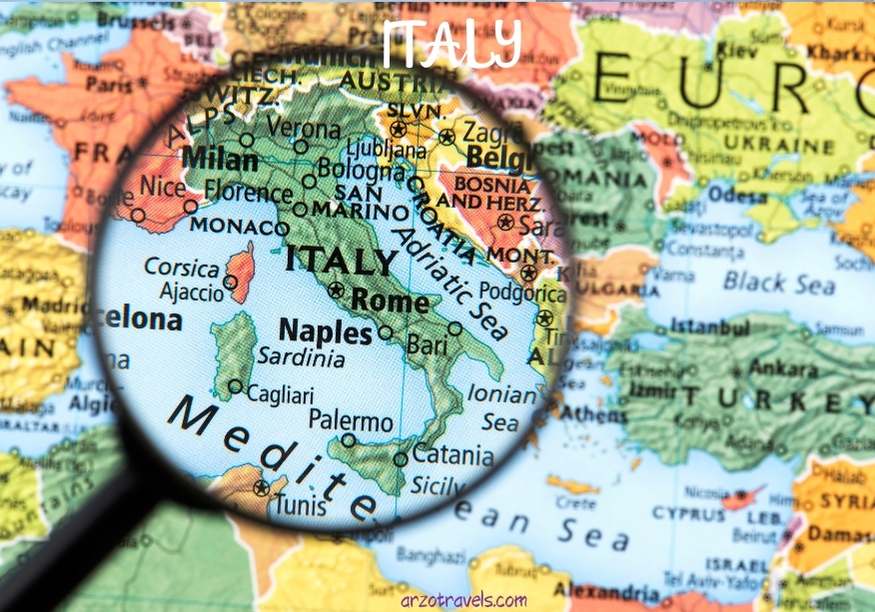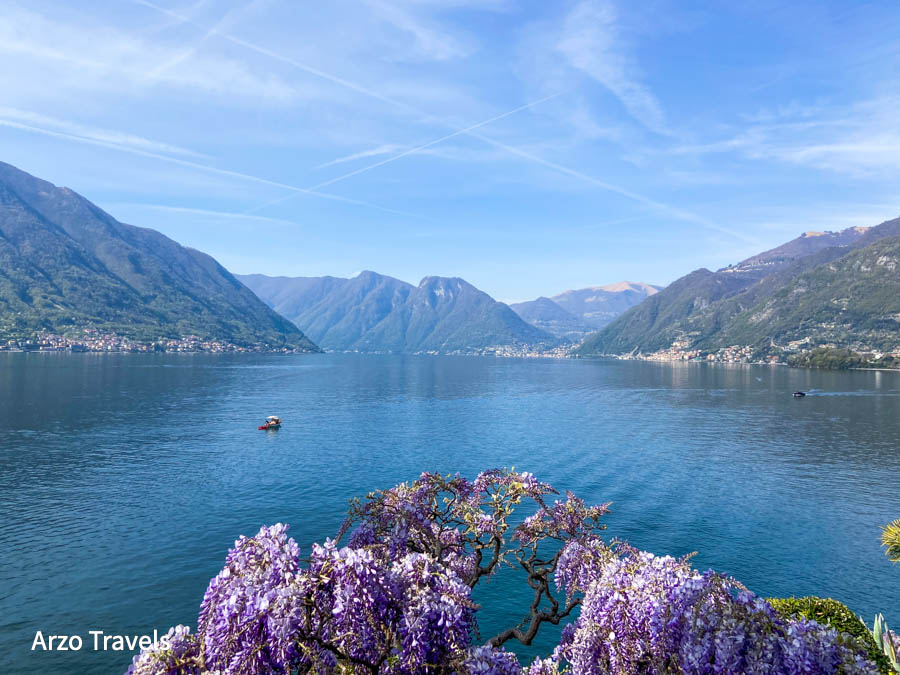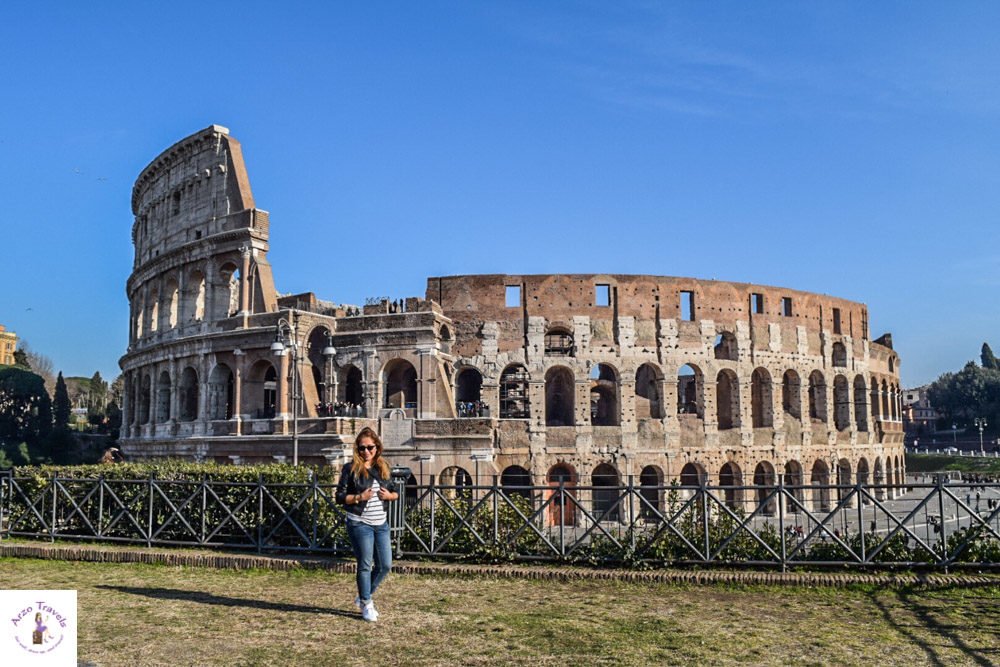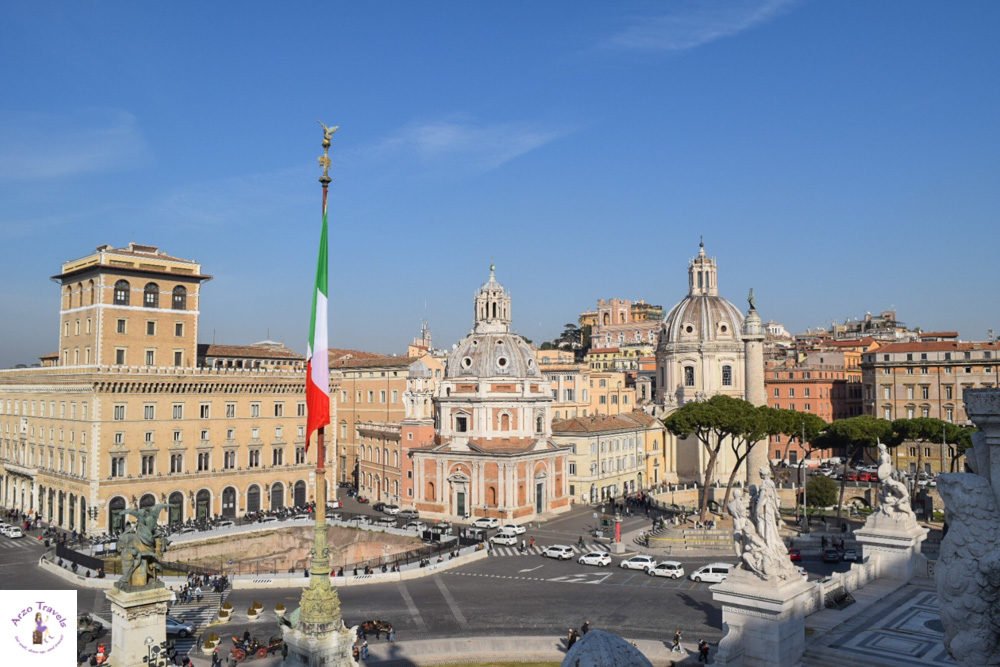HOW TO PLAN A TRIP TO ITALY
Italy is known for its stunning beauty, rich history, delicious cuisine, and iconic landmarks. From the historic ruins of Rome to the picturesque canals of Venice, Italy offers an endless array of attractions and experiences that leave a lasting impression on any traveler.
And after Switzerland, Italy is my second true love. This country is just gorgeous! I love Italy and I am sure, you will love Italy, too! If you are planning a trip to Italy, you might be wondering about how to plan a first-time trip to Italy.
Careful planning can help that your trip is as enjoyable and memorable as possible – and I share my travel tips for Italy with you.
Disclaimer: This post contains affiliate links. This means I might earn a small commission when you buy a product (at no extra cost for you) after clicking on my link. More about it here.
FAQs: PLANNING A TRIP TO ITALY
So, let´s start with some FAQs.
WHERE IS ITALY?
DO I NEED A VISA FOR ITALY?
If you are a citizen of the European Union (EU), Liechtenstein, Norway, or Switzerland, you do not need a visa to enter Italy.
If you are a citizen of a non-EU country, you may need a visa, depending on the length and purpose of your visit.
If you are a tourist or visiting for business purposes and your stay is less than 90 days, you may not need a visa, depending on your nationality. Citizens of some countries, such as the United States, Canada, Australia, and Japan, are allowed to enter Italy for tourism or business purposes without a visa for up to 90 days.
You should check with the Italian embassy or consulate in your home country to determine if you need a visa and what type of visa you need for your specific situation.
ARRIVING TO ITALY
Italy is well-connected to the rest of the world by various means of transportation. There are different ways to arrive in Italy, each offering its own unique experience.
🛬 One of the most common ways to arrive in Italy is by plane. The country has several international airports, including Rome Fiumicino, Milan Malpensa, and Venice Marco Polo, which serve as major hubs for international flights. Italy is also well-connected to other European countries by air, with many low-cost airlines operating flights to and from Italy.
🚆 Another way to arrive in Italy is by train. Italy has an extensive railway network that connects it to other European countries, making it easy to travel by train from neighboring countries such as France, Switzerland, and Austria. High-speed trains are also available within Italy, making it easy to travel quickly between major cities like Rome, Milan, Florence, and Naples.
🚗 / 🚌 Italy can also be reached by car or bus, with several international routes connecting Italy to neighboring countries. Italy’s highway system is extensive and well-maintained, making it easy to travel by car within the country.
🛥️ Italy can also be reached by sea, with several major ports such as Genoa, Naples, and Venice serving as hubs for ferry and cruise ship traffic. Arriving by sea can offer a unique perspective on the country’s stunning coastline and can be a great way to explore Italy’s islands and coastal towns.
BEST WAY TO GET AROUND ITALY
The best way to get around Italy largely depends on your itinerary, budget, and personal preferences. However, I do have a clear preference and I am sharing the different ways of getting around Italy with you now.
🚆 PUBLIC TRANSPORT
Italy has an extensive and well-connected public transportation system, making it easy to travel between major cities and tourist destinations by train, bus, or metro.
Trains are generally the fastest and most efficient way to travel between major cities in Italy. Trenitalia and Italo are the two main train operators in the country, offering high-speed trains and regional trains to various destinations throughout Italy.
Bus companies like Flixbus and Buscenter operate routes throughout Italy, offering affordable and comfortable travel between cities and tourist destinations.
In some cities, metro systems are also available for getting around, like Rome, Milan, or Naples.
Keep in mind that some rural or remote areas may not have access to public transportation.
🚗 ROAD TRIP / CAR
While public transportation is generally the best way to get around Italy, traveling by car can also be an option if you prefer flexibility and independence.
However, I really want to emphasize that driving in Italy can be challenging – particularly in major cities where traffic can be heavy, and parking can be difficult to find. Also, Italians tend to drive a bit recklessly and streets and roads can be narrow.
If you do decide to rent a car and drive in Italy, be aware of the local driving rules and regulations. Have a good GPS or map and be comfortable driving on narrow, winding roads.
Also, petrol and tolls are quite expensive which makes using public transport in Italy much more interesting.
Though I have driven in Italy many times, I definitely prefer using public transportation.
One advantage of traveling by car is that you can explore off-the-beaten-path destinations that are not easily accessible by public transportation. It also gives you the flexibility to make stops along the way and to explore at your own pace.
GET YOUR RENTAL CAR FOR YOUR ITALY TRIP HERE
HOW EXPENSIVE IS AN ITALY TRIP
The cost of traveling in Italy varies widely depending on your travel style, itinerary, and the time of year you visit.
Prices can vary significantly between popular tourist destinations and more off-the-beaten-path areas. For example, prices in cities like Rome, Florence, and Venice can be much higher than prices in smaller towns or rural areas.
Additionally, peak tourist season, which is typically during the summer months, can also result in higher prices for accommodations, activities, and transportation.
Here is a general overview of the cost of different types of accommodations, food, activities, and transportation in Italy.
BUDGET TRAVEL IN ITALY
For budget travelers, expect to spend around 20-50 Euros per night for a hostel or budget hotel room, depending on the city and location. Street food and budget restaurants are available, where you can enjoy a pizza or a sandwich for around 4-10 Euros.
Public transportation like buses and metros are relatively cheap, with tickets costing around 1-2 Euros for short distances.
MID-RANGE TRAVEL IN ITALY
For mid-range travelers, expect to spend around 70-150 Euros per night for a mid-range hotel room. You can also find nice bed and breakfasts and apartment rentals in this range.
You can enjoy a nice meal in a mid-range restaurant for around 15-30 Euros, and drinks in bars or cafes can cost around 4-8 Euros. Private transportation like taxis or rental cars can be more expensive, with prices varying based on the city and time of year.
LUXURY TRAVEL IN ITALY
Luxury travelers can expect to spend over 200 Euros per night for a luxury hotel or villa rental, depending on the location and time of year. You can enjoy fine dining at upscale restaurants, with prices ranging from 50-100 Euros per person or more. Private transportation options like limousines or private drivers can be arranged at a premium.
WHERE TO STAY IN ITALY
Italy has a wide range of accommodations, from luxury hotels to budget-friendly hostels, making it easy to find a place to stay that fits your budget and travel style. Here are some of the best areas to stay in Italy:
Rome: The historic center of Rome is a popular area for tourists, with plenty of hotels, B&Bs, and apartments to choose from. Staying in the historic center puts you within walking distance of many of the city’s top attractions, including the Colosseum, the Pantheon, and the Trevi Fountain.
- Luxury Hotels: The St. Regis Roma is one of the few hotel chains with a property in Rome. The hotel is popular because of its central location. It is within walking distance of Rome attractions like the Spanish Steps. ➡️ BOOK YOUR STAY AT ST. REGIS ROME HERE
- Mid-Range – Suites Farnese Design is a popular 3-star hotel that might be the perfect choice for your stay in Rome. ➡️ BOOK YOUR STAY AT SUITES FARNESE DESIGN HERE
- Budget – St.Peter´s Room Rome might be the perfect choice for you: We were a group of three and we were really, really happy with our hotel. It was not spectacular, but the location was good, and so was the value for money. ➡️ BOOK YOUR STAY AT ST.PETER´S ROOM ROME HERE
Florence: The city center of Florence is a charming area, with many beautiful hotels, apartments, and guesthouses located in historic buildings. The area is known for its art and architecture, with top attractions like the Uffizi Gallery and the Duomo located nearby.
- Luxury – Four Seasons Hotel Firenze For the ultimate luxury hotel, check out Florence´s Four Season rates. This hotel chain knows how to impress, and it seems that it does a great job in Florence, too. ➡️ BOOK YOUR STAY AT FOUR SEASONS HOTEL FIRENZE HERE
Mid-Range – Park Palace This mid-range hotel is located close to the Boboli Gardens and the Piazzale Michelangelo. ➡️ BOOK YOUR STAY AT PARK PALACE
- Budget- Plus Florence Plus Florence is a hostel near some of the main attractions, and you can book dorms or private rooms. ➡️ BOOK YOUR STAY AT PLUS FLORENCE
Tuscany: The countryside of Tuscany is a peaceful and picturesque area to stay, with many agriturismo (farm stays) and villas available for rent. Staying in the Tuscan countryside puts you within reach of charming towns like Siena and San Gimignano, as well as famous wine regions like Chianti and Montepulciano.
Venice: The heart of Venice is a unique and romantic place to stay, with many hotels and apartments located in historic buildings along the canals. Staying in the city center puts you within walking distance of top attractions like St. Mark’s Basilica and the Doge’s Palace.
- Luxury – Gritti Palace: Venice has some great 5* hotels like the Gritti Palace with a lovely view of the Grand Canal. ➡️ BOOK YOUR STAY AT GRITTI PALACE HERE
- Mid-Range – Antica Locanda Sturion Residenza dÉpocha: Travel back in time to the 18th century at Antica Locanda Sturion Residenza d’Epoca: antique furniture, silk wallpaper, and views of Rialto and Grand Canal. ➡️ BOOK YOUR STAY AT ANTICA LOCANDA STURION RESEDENZA d`EPOCA
- Budget – Locando Ca´Foscari: The family-run Hotel Locanda Ca’ Foscari offers some hotel rooms with ensuite bathrooms, as well as cheaper rooms with shared bathrooms, at a good location close to a Vaporetto ferry stop. ➡️ BOOK YOUR STAY AT LOCANDA CA´FOSCARI HERE
Amalfi Coast: The Amalfi Coast is a stunning area to stay, with many hotels and villas located in picturesque towns like Positano and Ravello. The area is known for its dramatic cliffs, colorful houses, and beautiful beaches.
These are just a few examples of the best areas to stay in Italy, and there are many other beautiful and unique areas throughout the country to consider.
BUCKET LIST ITALY
One could probably and easily name 1000 amazing activities for your Italy bucket list, but I tried to keep it short and simple, so here are 30 amazing things to do in Italy.
- Visit the Colosseum in Rome.
- See the stunning Vatican City and St. Peter’s Basilica.
- Explore the ancient ruins of Pompeii.
- Visit the Uffizi Gallery in Florence.
- Climb to the top of the Leaning Tower of Pisa.
- Take a gondola ride in Venice.
- See the beautiful Duomo in Milan.
- Visit the Amalfi Coast and explore the charming towns.
- Walk around the historic center of Siena.
- See the stunning architecture of the Cathedral of Santa Maria del Fiore in Florence.
- Visit the beautiful island of Capri.
- Follow the steps of Romeo and Juliet in Verona.
- See the ruins of the Roman Forum in Rome.
- Take a tour of the Vatican Museums.
- Explore the beautiful gardens of Villa Borghese in Rome.
- Visit the picturesque town of Positano on the Amalfi Coast.
- See the famous statue of David in Florence.
- Take a wine tour of Tuscany.
- Visit the beautiful beaches of Sardinia.
- Explore the charming hilltop towns of Umbria.
- Take a cooking class and learn to make authentic Italian cuisine.
- See the beautiful mosaics in Ravenna.
- Stroll one of the beautiful parks along the shores of Lake Como.
- Visit the beautiful town of Matera, known for its ancient cave dwellings.
- Take a bike ride through the beautiful countryside of Tuscany.
- Go skiing in the Italian Alps.
- Visit the charming town of Lucca and walk along its historic walls.
- Explore the beautiful Cinque Terre coastal towns.
- Take a tour of the beautiful Baroque city of Noto in Sicily.
- Visit the beautiful island of Sicily and explore its historic sites and stunning coastline.
BEST TIME TO VISIT ITALY
Italy is a year-round destination. Here is a breakdown of the different seasons and months in Italy:
Spring (March-May): Spring is a great time to visit Italy, as the weather is mild, and the crowds are still relatively low compared to the peak summer months. In March and April, you may still encounter some rainy days, but by May, the weather is generally sunny and warm. Spring is a great time to explore cities like Rome, Florence, and Venice, as well as to enjoy outdoor activities like hiking and biking in the countryside.
Summer (June – August): Summer is the peak tourist season in Italy, and the weather is hot and sunny. This is a great time to visit the beaches along the Amalfi Coast, as well as to enjoy outdoor festivals and events throughout the country. However, be prepared for large crowds and high prices, particularly in popular tourist destinations like Rome, Florence, and Venice.
Fall (September – November): Fall is a great time to visit Italy, as the weather is mild, and the crowds are starting to thin out. The countryside is particularly beautiful in the fall, with vineyards and olive groves turning golden brown. This is a great time to explore Tuscany, Umbria, and other wine regions, as well as to enjoy fall festivals and events throughout the country.
Winter (December – February): Winter in Italy is generally mild, but it can be cold and rainy, particularly in the north. However, this is a great time to visit cities like Rome and Florence, as the crowds are low, and prices are often lower than in the peak summer months. Winter is also a great time to go skiing in the Italian Alps or to enjoy winter festivals and events throughout the country.
Overall, the best time to visit Italy depends on your travel style and interests. If you prefer mild weather and fewer crowds, the spring and fall months are a great choice, while those who enjoy hot weather and outdoor activities may prefer the summer months.
ITALY ITINERARY
Planning an itinerary for your trip to Italy can be an exciting but daunting task. With so many beautiful cities, towns, and attractions to choose from, it can be challenging to decide where to go and what to see.
However, careful planning and consideration can help you create an itinerary that suits your interests and allows you to make the most of your time in Italy.
By taking the time to research and plan your itinerary, you can create a memorable and enjoyable trip to Italy that reflects your unique interests and travel style.
Here are a couple of itineraries for Italy:
- 2-week Italy itinerary
- 7 days in Tuscany
- 2 days in Rome
- Florence in 2 days
- Itinerary Lake Como
- Places to visit in Lake Garda
- 1 day in Verona
CHECKLIST – PLAN A TRIP TO ITALY
Here are important steps to plan and book a trip to Italy:
- Determine your budget for the trip. ✔️
- Check passport and visa requirements for your country of origin. ✔️
- Decide on your travel dates and the length of your trip. ✔️
- Research and select your destinations within Italy. ✔️
- Book your flights to Italy. ✔️
- Research and book your accommodation, whether it’s a hotel or a hostel. ✔️
- Look into public transportation options, and purchase tickets in advance if necessary, or rent a car. ✔️
- Research and book any activities or tours you want to do, such as hiking, skiing, or sightseeing. ✔️
- Check the weather forecast and pack accordingly. ✔️
- Purchase travel insurance to protect against any unforeseen events. ✔️
- Create a packing list and make sure to bring any necessary items, such as a power adapter or hiking gear or medication. ✔️
- Notify your bank of your travel plans and bring a credit card, change some money if necessary ✔️
- Download any necessary apps, such as transportation or translation apps. ✔️
- Print out important documents, such as flight and hotel confirmations, and bring copies with you. ✔️
- Double-check everything before you leave, including your travel documents, itinerary, and packing list. ✔️
FINAL THOUGHTS ON PLANNING A TRIP TO ITALY
Bella Italy is always worth a trip and planning a trip to Italy can be an exciting and rewarding experience, but it requires careful consideration and planning.
To ensure a smooth and amazing trip, it’s important to research the best time to visit, the different modes of transportation available, the cost of accommodations and activities, and the top attractions and destinations to visit.
Remember to pack weather-appropriate clothing and comfortable footwear, as well as any necessary medications or travel documents. With its rich culture, history, and stunning natural landscapes, Italy offers a wealth of experiences for travelers of all interests and backgrounds.
By planning ahead and staying open to unexpected experiences, you can create an amazing trip to Italy that will stay with you for a lifetime.
Enjoy your time in Bella Italia!







